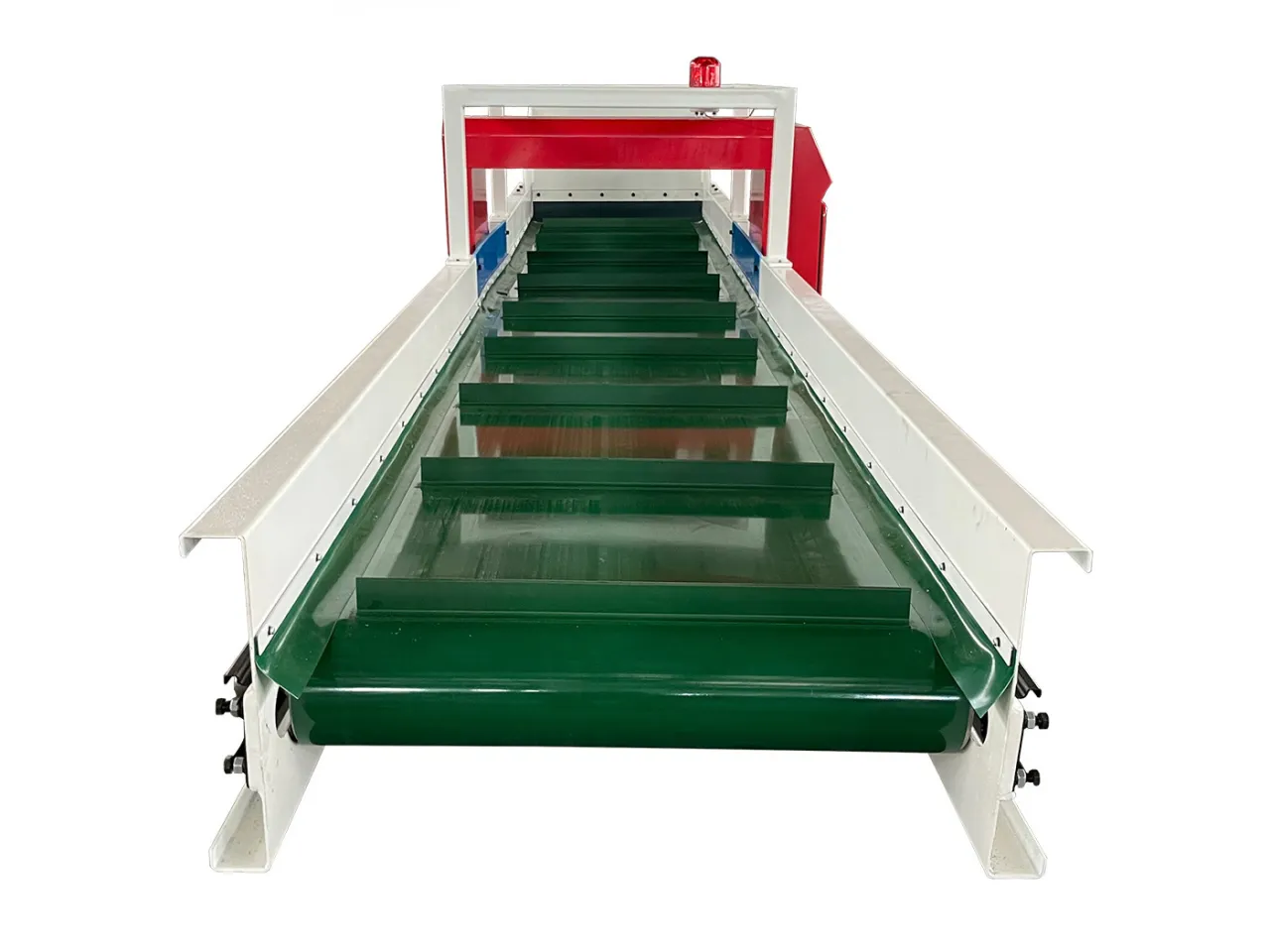Metal Detector on Plastic Recycling Conveyor Belt
Protect downstream equipment and ensure product purity with advanced metal detection technology. Instantly identify ferrous, non-ferrous, and stainless steel contaminants in your plastic recycling stream with audio-visual alarms and optional automatic rejection systems.
Why Install a Metal Detector on Your Conveyor
Critical protection for expensive downstream machinery and consistent product quality in plastic recycling operations.
Equipment Protection
Prevents costly damage to shredders, granulators, extruders, and other processing equipment by detecting metal before it enters machinery.
Product Quality
Ensures output material meets purity standards, eliminating metal contamination that could affect end-product quality.
Multi-Metal Detection
Identifies ferrous metals (iron, steel), non-ferrous metals (aluminum, copper, brass), and stainless steel contaminants.
Real-Time Detection
Continuous monitoring at line speed with instant audio-visual alarms when metal contaminants are detected.
Minimize Downtime
Reduce unplanned maintenance stops and emergency repairs caused by metal contamination damaging equipment.
High Sensitivity
Detects even small metal fragments (down to 1-2mm depending on configuration) hidden within plastic material flow.
Easy Integration
Mounts directly onto existing conveyor systems with minimal modification and integrates with reject mechanisms.
Data Logging
Track detection events, alarm history, and system performance for quality control and process optimization.
How Metal Detection Works
Electromagnetic field technology combined with automated rejection for reliable contamination control.
Material Flow
Plastic materials travel along the conveyor belt through the detector tunnel or aperture at normal processing speed.
Field Generation
The detector creates a balanced electromagnetic field across the conveyor belt width using precision coils.
Metal Detection
Any metal passing through disrupts the electromagnetic field. Sensors instantly detect this disturbance and trigger an alarm.
Alarm & Response
System triggers audio-visual alarm. Operator stops line to remove contaminant, or optional auto-rejection system diverts material.
Applications in Plastic Recycling
Essential protection across every stage of the plastic recycling process.
Post-Collection Sorting
Detect metal contaminants in mixed plastic waste before sorting and washing processes to protect separation equipment.
Pre-Shredding Protection
Install before shredders and granulators to prevent blade damage, motor overload, and catastrophic equipment failure.
Post-Washing Verification
Verify material purity after washing operations, catching metal fragments released during the cleaning process.
Pre-Extrusion Quality
Final check before extruders and pelletizers to ensure only clean material enters high-value processing equipment.
Finished Product QC
Verify final pellet or flake output meets customer specifications and industry purity standards.
Bale Processing Lines
Monitor material as bales are opened and fed onto processing lines to catch wire, staples, and other metal debris.
Technical Specifications
Typical configurations for plastic recycling conveyor applications. Custom sizes and sensitivities available.
| Parameter | Standard Configuration |
|---|---|
| Detection Aperture Width | 300mm - 1500mm (customizable) |
| Detection Aperture Height | 80mm - 300mm (customizable) |
| Belt Speed Compatibility | Up to 120 m/min |
| Ferrous Metal Sensitivity | Fe Ø1.0mm (depends on aperture size) |
| Non-Ferrous Metal Sensitivity | Ø1.5mm - 2.0mm (aluminum, copper, brass) |
| Stainless Steel Sensitivity | SUS Ø2.0mm - 3.0mm |
| Detection Method | Balanced coil electromagnetic induction |
| Power Consumption | ≤200W |
| Alarm System | Audio + visual + relay output |
| Display Interface | LED / LCD touchscreen (model dependent) |
| Operating Temperature | -10°C to 50°C |
| Frame Material | Stainless steel 304 |
Maintenance & Safety Considerations
Keep your metal detector operating at peak performance with regular maintenance and proper calibration.
Regular Inspections
Daily visual checks of detector housing, conveyor belt condition, and reject mechanism function. Weekly test piece verification.
Cleaning Routine
Clean detector aperture and conveyor belt regularly to prevent material buildup that could affect detection sensitivity.
Calibration Checks
Monthly calibration verification using certified test pieces. Re-calibrate after any equipment relocation or major repairs.
Operator Training
Ensure staff understand test procedures, alarm responses, and basic troubleshooting before operating the system.
Documentation
Maintain logs of detection events, calibration records, and maintenance activities for quality assurance and audits.
Safety Measures
Install emergency stops, safety guards around reject mechanisms, and clear signage for contamination collection areas.
Frequently Asked Questions
What types of metals can the detector identify?
The detector identifies all three categories of metal contaminants: ferrous metals (iron, steel), non-ferrous metals (aluminum, copper, brass, lead, zinc), and stainless steel (300-series and 400-series). Detection sensitivity varies by metal type and detector aperture size.
How small a metal piece can be detected?
Sensitivity depends on the detector aperture size and metal type. Typical performance: ferrous metals down to 1.0mm diameter, non-ferrous down to 1.5-2.0mm, and stainless steel down to 2.0-3.0mm. Smaller apertures provide higher sensitivity for fine contaminants.
Can it work with my existing conveyor system?
Yes, metal detectors are designed to integrate with existing conveyor systems. We custom-size the aperture to match your belt width and material depth. The unit mounts either directly over the belt or as a tunnel the belt passes through, depending on your layout.
What happens when metal is detected?
When metal is detected, the system immediately triggers an audio-visual alarm to alert operators. Standard configuration requires manual line stoppage to remove the contaminant. For automated operations, optional rejection systems (air blast diverters, mechanical pusher arms, or drop-flap gates) can be integrated to automatically divert contaminated material into a reject bin without stopping the line.
Does moisture or product variation affect detection?
Modern detectors include automatic product compensation to adjust for moisture content, temperature, and material density variations. You can store multiple product presets for different plastic types (PET, HDPE, PP, etc.) to maintain optimal sensitivity across your material mix.
How often does the detector need calibration?
We recommend monthly calibration verification using certified metal test pieces. Recalibration is needed after relocating the unit, changing conveyor configuration, or if test piece verification fails. Some facilities calibrate weekly for critical applications or regulatory compliance.
Can I customize the aperture size?
Absolutely. We custom-build apertures to match your specific belt width (300mm to 1500mm+) and material bed height (80mm to 300mm+). Smaller apertures provide higher sensitivity, while larger apertures accommodate high-volume applications.
Configure Your Metal Detection System
Share your belt width, line speed, material type, and sensitivity requirements. Our engineers will recommend the right detector configuration for your application.



